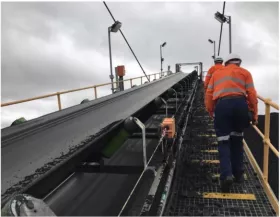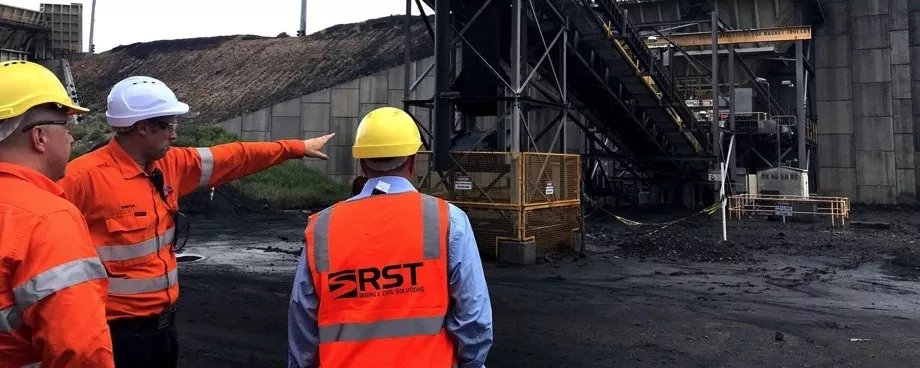Further Testing
A range of tests on DEM Hydroboost Pro were recently conducted during a series of field trials throughout the mine’s supply chain from pit to port with further testing of the coal after it was shipped to another country. When the coal was received by the customer, tests proved DEM Hydroboost Pro was still active, and reports were of a much more manageable product.
A gentle spray of water is all the material needed to reactivate the chemistry, requiring very little effort to generate the right amount of moisture for improved and continued dust management.
If a mining company chemically modifies their ore so that DEM is reduced by over 2%, which can reduce the amount of water required to attain DEM by up to 40%, several advantages can be accomplished:
- Improved health and safety: By reducing the moisture content of the ore, there would be less dust generated during handling, transportation, and processing, which can improve the working environment for mine workers and reduce the risk of respiratory illnesses.
- Enhanced efficiency: Drier ore is easier to handle, transport, and store, as it is less likely to stick to equipment or form lumps that can cause bottlenecks in the production process. This can lead to faster and more efficient production and lower operating costs.
- Lower water consumption: With lower DEM, the need for water to control dust and regulate moisture content would be reduced, potentially lowering water usage and costs.
- Reduced shipping costs: With less moisture in the ore it is lighter, and thus requires less energy to transport, leading to lower shipping costs.
- Improved product quality: Drier ore may improve product quality by reducing the potential for clogging and improving the ability to control particle size and shape, leading to a more consistent and higher-quality end product.
At the Coal Face
Coal mines use bulldozers to move the coal around and push it into chutes to load conveyors, using water to try and reach their target DEM and stop it from becoming like a dust storm.
Adding a product like DEM Hydroboost Pro – which holds a satisfactory level of moisture to improve dust control without altering the mined material – not only assists operators to significantly reduce the amount of water normally used to suppress dust, but also offers greater levels of dust and moisture control, holding dust down at higher wind speeds.
DEM Hydroboost Pro has the potential to assist in keeping operations open in stronger windy conditions. For example, an Australian coal mine that was forced to stop operations when wind gusts reached speeds of 9 m/sec. decided to apply DEM Hydroboost Pro. Post-application, and the coal was still holding down the dust when winds were 12 m/sec., enabling the mine to ship another 1 million tpy of coal.

Added Advantages
There are advantages that come with applying a product like DEM Hydroboost Pro to minerals in the early stages of mining, especially during the mineral/waste separation process.
At this point the dry waste is fine and super dusty, and common practice is to just add water until the required DEM is achieved. It is then conveyed by dump trucks to massive waste dumps.
Water constraints and increasing costs make wet mineral extraction impractical and unsustainable in many parts of the world, with altemative solutions being sourced by mines to meet dust control regulations and save money.
Treating mineral material during the dry separation process offers mines additional advantages by treating waste at the same time, which significantly reduces the amount of water needed (with some additional binding) to minimise fugitive dust liftoff when dumped.
The waste product is separated in a dryer form with a much better DEM, reducing the need for tailings dams to store wet waste. Another advantage is the crusting effect when treated waste is dumped, providing ongoing waste dump surface dust suppression.
Conclusion
Meeting DEM requirements and sourcing efficient and cost-effective solutions for dust control and water management are a priority for mine site operators.
Advanced treatments like DEM Hydroboost Pro make the process more efficient and cost-effective, by reducing the total volume of water needed to achieve the desired DEM.
Coal mines trialling DEM Hydroboost Pro have found it can offer many advantages, including superior dust control with reduced risk of excess moisture creating handling problems. By reducing the amount of water required to suppress dust at the mine and during stockpiling, haulage, and transfer points, significant water savings can be made while product quality has been maintained.
Field test results have shown that DEM Hydroboost Pro offers a typical reduction of between 2.5 – 3.5% in a material’s DEM, which is significant considering that a typical DEM reduction is around 7 – 126. Approximately 40% less water is required to achieve DEM using DEM Hydroboost Pro, providing a much more even water spread throughout the material without draining through the coal.
After applying RST Solutions’ new advanced product DEM HydroBoost Pro, the mined material showed a significant drop in DEM from 9.2 to 5.4, which translates to a 3.8% reduction in moisture, resulting in 426 less water used, which is significant for a mine in achieving its environmental and budgetary obligations. “
■
















